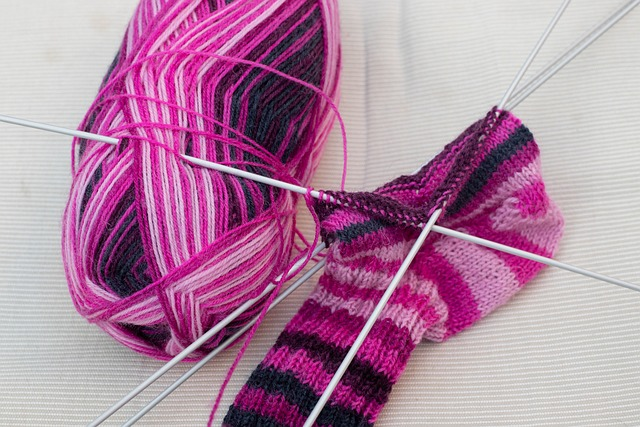Imagine your favorite pair of socks are as shifty as a weasel in a hen house, constantly slipping off your feet. It's an annoyance you've probably faced more than once. What if you could shrink them to a snug fit without damaging the material?
Intriguing, isn't it? Our Ultimate Guide to Shrinking Socks for a Snug Fit can help you master the art of resizing socks to perfection. Stay with us as we unravel some surprisingly simple techniques that will transform your sock-wearing experience forever.
Understanding Sock Materials
Diving into the world of sock materials, it's crucial to understand that the composition of your socks greatly impacts how effectively they can be shrunk for that perfect fit.
For instance, wool socks made purely from super wash wool won't shrink, due to the absence of nylon in the material. This is a crucial detail to remember when you're considering the shrink ability of your socks.

On the other hand, wool-nylon blend socks shrink more effectively than those without nylon. This is because materials like nylon react when exposed to heat, which can help you get that snug fit you're after.
For those who prefer synthetic fibers, you're in luck. Nylon, polyester, and other synthetic materials shrink more efficiently than pure cotton or wool socks. This fact could prove useful when you're trying to shrink your polyester socks.
Why Size Matters in Socks
Having considered the significance of sock materials in achieving the perfect fit, let's now look at why the size of your socks matters just as much. It's clear that ill-fitting socks can cause a myriad of foot problems. When your socks are too loose, they can slip and rub against your skin, leading to blisters and irritation. On the other hand, socks that are too tight can restrict blood flow, causing discomfort and potential health issues.
Obviously, avoiding these problems is crucial. That's where understanding your sock size and how to shrink socks for a snug fit comes in handy. The right-sized socks won't slip or restrict your circulation. They'll stay put, providing the comfort and protection your feet need for daily activities.
But how do you achieve that snug fit? The answer is simple: shrinking your socks. By following the tips and techniques in 'The Ultimate Guide to Shrinking Socks', you can adjust the size of your socks to fit your feet perfectly. This not only prevents discomfort and foot problems, but it also enhances your overall sock-wearing experience. In a nutshell, size does matter in socks.
Unconventional Uses for Shrunken Socks
Often, you'll find that socks accidentally shrunk in the wash can actually be repurposed in a number of creative and practical ways. For instance, you can transform these shrunken socks into handy cleaning rags. They're perfect for dusting and wiping down surfaces, making them a great DIY solution for household chores.
But the fun doesn't stop there. Got kids or pets? Why not turn those shrunken socks into adorable puppets or stuffed toys? It's a fun and simple DIY project that not only recycles but also sparks creativity.
Now, let's talk about protection. Shrunken socks can serve as protective covers for your delicate items. Glasses, electronics, or anything fragile can be snugly wrapped in a sock for an added layer of protection. It's an unconventional but effective way to avoid scratches and damage.
Step-by-Step Shrinkage: Boiling Water Method
While repurposing shrunken socks can be incredibly handy, there's also a way to intentionally shrink your socks for a better fit, starting with the boiling water method. This technique works best for cotton or wool socks, and it's fairly straightforward.
First, bring a pot of water to a boil. Once the water's bubbling away, submerge your socks. Let 'em soak in the boiling water for about ten minutes. This is the key to triggering the shrinkage. The heat from the boiling water causes the fibers in your socks to contract, resulting in a snugger fit.

But don't just yank them out once the timer dings. It's critical to rinse your socks in cold water immediately after boiling. This step halts the shrinkage process and helps set the new size. Then, simply lay your socks flat to dry.
Congrats! You've just mastered the boiling water method. So next time you're stuck with socks that are just too loose, remember this trick. It's a safe, efficient way to achieve that snug, tailored fit you're after. No more sliding socks for you!
Step-by-Step Shrinkage: Freezer Method
If you're looking for a chill way to shrink your socks, you'll love the freezer method. It's an easy, safe way to get that snug fit without damaging your socks. The cold temperature of your freezer does the work for you. Here's how it works: the cold causes the fibers in your socks to contract, effectively reducing their size.
First, seal your socks in a plastic bag. Next, pop the bagged socks into the freezer. Leave them in there for a full 24 hours to ensure the fibers contract sufficiently. This patience will pay off with the snug fit you're aiming for.
After the 24-hour freeze, it's important to let your socks thaw out at room temperature. Don't rush this process; letting them naturally return to room temperature will ensure the fibers settle properly. Finally, once they're thawed, dry them off. You'll find they've shrunk down to a much snugger, more comfortable fit.
Step-by-Step Shrinkage: Oven Method
After mastering the freezer method, you're ready to tackle another effective technique for shrinking socks: the oven method. This method is safe and convenient, giving you better fitting socks in just a few steps.
Start by washing your socks on a cool wash setting. This helps remove any excess water and preps the fabric for the shrinking process. After washing, don't put them in the dryer. Instead, preheat your oven to 200°F.
Once the oven is ready, place the socks on a baking sheet and slide them in. Make sure they're spread out evenly to allow for uniform shrinkage. Bake them for 15 minutes, but keep a close eye on them to prevent any scorching.
When the time's up, carefully remove the socks from the oven using oven mitts to protect your hands. Place them somewhere safe to cool down. It's important to let them cool at room temperature before trying them on. This ensures the shrinking process is complete and your newly sized socks are ready for you to enjoy their snug, improved fit.

Remember to use the oven method responsibly and never leave your oven unattended.
Best Practices for Shrinkage
Let's dive into the best practices for shrinking socks to ensure a perfect fit every time. The key is understanding the composition of your socks. Pure cotton socks will shrink more than blends due to their natural properties, so adjust your heat and water levels accordingly. Using high temperatures, you'll soak your socks to contract the fibers and reduce their overall size.
Monitoring is crucial in this process. Watch your socks closely to prevent over-shrinking and to guarantee the desired fit. Remember, the goal isn't to create toddler-sized socks, but to achieve a snug, comfortable fit.
Once your socks have shrunk to the perfect size, proper care techniques are vital for maintaining that fit in the long term. Heat is your ally in the shrinking process, but can also be your enemy when it comes to maintaining the size. Always wash your newly shrunk socks in cold water and allow them to air dry to preserve their new size.
Shrinking socks is a simple and effective way to ensure a perfect fit. With careful heat application, diligent monitoring, and proper care, you'll have socks that fit like a glove in no time.
Potential Risks of Shrinking Socks
While the process of shrinking socks can be effective for achieving a more comfortable fit, you should also be aware of certain risks associated with this method. Different materials react differently to warm water and heat - the key elements in the shrinking process. Wool socks, for instance, may shrink more than you'd expect, risking them becoming too small. Cotton socks aren't immune either, they can shrink excessively if not watched carefully.
Over shrinking is a potential pitfall you need to avoid. It's especially applicable to synthetic socks made from materials like polyester. Over-do it and you could end up with socks that have lost their shape and are irreversibly damaged. These materials may shrink effectively, but they require careful handling to prevent over-shrinking.
Understanding the composition of your socks is crucial. Certain materials can withstand the shrinking process better than others, while some may react negatively. So, before you plunge your socks into warm water, make sure you've done your homework. It's better to be safe and keep your feet happy than to end up with a pair of socks that have shrunk beyond usefulness.
Shrinkage Success Stories
Countless sock wearers have shared their successful shrinkage stories, demonstrating the effectiveness of various methods ranging from boiling water to freezing, and even oven baking. You might be curious to know how each method pans out, so let's dive into some tales of success.
Many have found success with the boiling water method. They've immersed their oversized socks in boiling water, left them to soak for a bit, and voila! The socks shrink to provide a snug fit. Then there's the freezer method, where folks have frozen their socks in a sealed bag for a full 24 hours and achieved remarkable shrinkage.
The oven method has also won fans, with users baking their socks at 200°F for 15 minutes, resulting in a better fit. But remember, the key to these success stories isn't just about the method used, it's also about understanding the sock materials. Some materials may respond differently to each method, so tread wisely!
Despite the method you choose, remember the goal is the same: to shrink your socks for that perfect, snug fit. Success is possible, and these stories prove it!
Expert Tips for Perfect Fit
Building on these success stories, we're now ready to share expert tips to ensure your socks fit just right every time.
The first tip is that you can shrink your socks by boiling them for 15 minutes. This method is effective, but be careful not to overdo it. Too much heat can damage the material, so always keep an eye on your socks while they're in the boiling water.
Another technique is to freeze your socks. Seal them in a plastic bag and leave them in the freezer for 24 hours. The cold temperature will cause the fibers to contract, resulting in a snug fit. However, remember to let your socks thaw naturally to prevent any damage.
If you're not a fan of boiling or freezing, you can try baking your socks in the oven at 200°F for 15 minutes. It's a safe method for shrinking, but always stay nearby to avoid any mishaps.
Shrunken Socks and Foot Health
You mightn't realize it, but shrinking your socks for a perfect fit can significantly enhance your foot health. Ill-fitting socks can result in blisters and discomfort, but when you shrink your socks to fit just right, you'll reduce friction and abrasions, promoting overall foot comfort and health.
Shrunken socks also provide better cushioning and support for your feet. This enhanced comfort can help reduce the risk of foot issues, making your daily activities more enjoyable. And it's not just about comfort. Properly fitting socks can maintain correct alignment and support for your feet, contributing to better posture and movement.
Another benefit you'll gain from shrinking your socks is improved moisture management. Loose or oversized socks can trap perspiration, creating a fertile environment for fungal infections. But when your socks fit snugly, they manage sweat effectively, keeping your feet dry and reducing the chances of infection.
Prosthetic Socks: A Special Case
While shrinking regular socks for a better fit greatly improves foot health, let's not overlook the importance of perfect fit when it comes to prosthetic socks. These special socks, designed to prevent blisters and ulcers caused by friction, are indispensable for your comfort and overall foot health.
Choosing the right size, shape, thickness, and ply of prosthetic socks is crucial to maximize comfort, manage perspiration, and provide cushioning within the prosthesis socket. However, you can't just shrink these socks like regular ones. You'll need to start with a sheath and liner, ensure no skin contact, smooth out wrinkles, and insert the locking pin correctly. This might sound daunting, but it's worth the effort for the perfect fit.
Don't skimp on maintaining your prosthetic socks either. Buy them in bundles for convenience and make sure to follow washing instructions to the T. Daily changes, hand washing with mild soap, and air-drying away from sunlight will keep them in top shape. Remember, a well-fitted prosthetic sock doesn't just mean comfort, it's a significant contributor to your foot health.
Caring for Your Shrunken Socks
After successfully shrinking your socks for that perfect fit, it's essential to properly care for them to maintain their quality and snugness. Following the manufacturer's care instructions is a no-brainer. It's key to maintaining the longevity of your newly shrunken socks.
Hand washing is another crucial care tip. You may be tempted to toss them in the washing machine, but hold up! Hand wash them gently using mild soap. It's the best way to care and maintain the snug fit you've worked so hard to achieve. And remember, dry them away from direct sunlight. The sun can cause your socks to shrink further, which you definitely don't want!
Another tip is to smooth out any wrinkles before wearing your socks. This not only ensures comfort but also helps in maintaining the shape. And as a general rule, change your shrunken socks daily. It's good hygiene and prevents excessive wear.
Troubleshooting Shrinkage Problems
Navigating through shrinkage problems can be tricky, but with the right strategies, it's possible to avoid over-shrinking and damaging your socks. Remember, different fabrics react differently to heat and water, so understanding your socks' material is critical. Wool, for example, is susceptible to excessive shrinkage, while polyester and nylon shrink more predictably.
To avoid over-shrinking, closely monitor the process. Gradually adjust heat and time settings, starting low and slowly increasing until you reach the desired fit. It's easy to overdo it, so patience really is key here. And don't neglect to consider the sock's original care guidelines; these often provide useful insights into how the material reacts to various treatments.
Sometimes, despite your best efforts, problems occur. Socks can end up too small or become misshapen. Don't panic though. Most issues have solutions, so long as you don't rush or force the process. In these situations, it's best to revisit the care guidelines for your specific socks and try a softer approach.
Troubleshooting shrinkage problems doesn't have to be daunting. With careful attention and patience, you can successfully shrink your socks without causing damage.
Expanding on Shrunken Socks
Even though you've managed to shrink your socks successfully, there might come a time when you need to reverse the process and expand them back to their original size. Perhaps you've overdone the shrinking, or maybe your feet have grown. Whatever the reason, expanding your shrunken socks is possible with a bit of patience and the right techniques.
First, soak your socks in a basin of lukewarm water. The warmth of the water will help the fibers relax, allowing them to stretch back out. While they're soaking, gently pull on the socks to help them regain their original shape. Remember, the key is to be gentle - too much force can damage the fibers.
Once you've stretched your socks out, it's time to dry them. Avoid high heat, as this can cause the fibers to shrink again. Instead, lay them flat on a towel and let them air dry naturally.
Monitoring the temperature and your socks' progress is crucial during this process. Also, remember the care techniques you've learned - washing in cold water and air drying can help maintain your socks' size once they've been expanded. Keep these tips in mind, and you'll be able to expand your socks back to a comfortable fit in no time.
Conclusion
So, there you have it – your ultimate guide to shrinking socks for a snug fit. With a little patience and the right techniques, you can bid farewell to loose, uncomfortable socks.
Remember, it's all about choosing the right material, understanding the shrinkage process, and caring for your shrunken socks.
Now, go forth and conquer the world of snug socks. After all, nothing beats the comfort, security, and confidence that come from wearing perfectly fitting socks.
If you liked this article and would like to read more, try reading our guide on how to whiten your dirty white socks!
